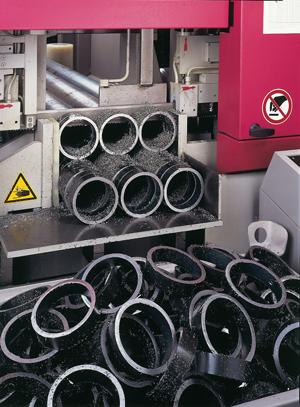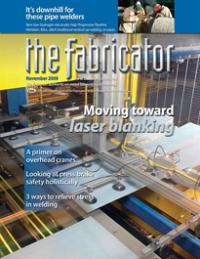- FMA
- The Fabricator
- FABTECH
- Canadian Metalworking
Categories
- Additive Manufacturing
- Aluminum Welding
- Arc Welding
- Assembly and Joining
- Automation and Robotics
- Bending and Forming
- Consumables
- Cutting and Weld Prep
- Electric Vehicles
- En Español
- Finishing
- Hydroforming
- Laser Cutting
- Laser Welding
- Machining
- Manufacturing Software
- Materials Handling
- Metals/Materials
- Oxyfuel Cutting
- Plasma Cutting
- Power Tools
- Punching and Other Holemaking
- Roll Forming
- Safety
- Sawing
- Shearing
- Shop Management
- Testing and Measuring
- Tube and Pipe Fabrication
- Tube and Pipe Production
- Waterjet Cutting
Industry Directory
Webcasts
Podcasts
FAB 40
Advertise
Subscribe
Account Login
Search
Band saw or circular cold saw?
Getting the most saw for your buck
- By Frank Truckly
- November 2, 2009
- Article
- Sawing

Because band saws accept a greater variety of bundled parts, comparing their productivity to that of circular saws isn't straightforward.
It's a common question. Band saw or circular cold saw: Which best fits my operation? Make the wrong choice in the short term and your productivity and potential to compete for new business could be compromised in the long run.
Long considered the shop floor's workhorse, band saws have advanced in many areas. Bundle-cutting capabilities (see Figure 1); more accurate feed units via servo drives; gear motor speed and horsepower options; programmable workstations for repeat jobs; carbide-tipped saw blades; and the ability to achieve smooth cuts in tough materials represent just some of the features and benefits found in today's band saws.
Circular cold saws offer high-speed cutting and high-quality finishes (see Figure 2 and Figure 3). The most basic manual units perform simple, low-volume cuts across a wide spectrum of materials, while automated, enclosed machines work well for production runs and repetitive projects.
A few years back the choice between a circular cold saw and band saw was a bit simpler. A high-volume, high-production application likely would require a circular cold saw. If tolerance and finish were not critical, a less expensive band saw probably would have sufficed. But today, because of technical advancements, the answer is less clear-cut.
To be sure, "slugging away" with a circular cold saw will always offer the most efficient and cost-effective approach in certain circumstances, particularly when finish is critical, or when utilizing a high-speed carbide cutting saw. Although more expensive, a carbide cutting saw reduces cut time dramatically.
The performance characteristics between these two technologies have begun to blur. Circular cold saws still deliver high speed and good finish. Band saws generally are less expensive and offer greater flexibility in the long run in terms of saw capacity, layer-cutting, and bundle-cutting. But a high-quality band saw may be able to meet or exceed performance expectations that previously were achievable only with a circular cold saw.
Material Type and Diameter
What material diameters will you cut on this machine? What material types and grades? Which materials will you cut most often? Will you be cutting solids, tubes, or both? Will future projects change your requirements? Do you envision offering additional cutting capabilities to new markets?
Generally, the maximum diameter for circular cold saws is between 5 and 6 inches.
Beyond that, the decision from both a capabilities and cost perspective falls clearly into the band saw camp. Workpiece diameters between 1 and 5 in. could go either with band saws or circular cold saws. Which to choose depends on various factors.
In cold sawing, the idea is to get into and out of the material quickly. More common grades of steel lend themselves better to circular saws. They can be cut quickly without generating excessive heat and friction, which can cause premature wear on a circular saw blade and thus affect the finish. Tougher nickel-based materials are slow-cutting.
The continuous blades on band saws run slower and have many more cutting edges, which provide more time for the blade to cool between entering and exiting the material.
Past and Future Production Requirements
How many pieces do you need to cut on an hourly, daily, weekly, or monthly basis? Will these be long, production-type runs, short runs, or individual cuts? Will production requirements shift to larger runs in the future? For any scenario, what are the sizes, grades, and quantities of the materials to be cut?
Band saws today have advanced layer- and bundle-cutting capabilities, allowing for higher production on small-diameter pieces, as well as the ability to hold tighter tolerances. If you can cut pieces in layers, then a band saw can compete nicely with the volume throughput of a circular cold saw. Perhaps you can cut one 2-in. 4140 solid bar every 10 seconds on a standard cold saw, but if you cut a layer of five 2-in. pieces on a band saw in 70 seconds, then that may well meet your production requirements. With advancing band saw blade technologies and the ability of dual-column saws to maintain very high band tension via their rigid design, plus the technology to maintain a constant chip load, a band saw's tolerances and consistency have improved dramatically.
By cutting layers or bundles, you reduce the index time as well. If you do plan to bundle material, consider the clamping requirements. Cold saws can indeed bundle-cut, but only small-diameter components and by using special fixtures. For bundling larger- diameter parts, band saws remain the only option. Bundling square or rectangular tubing may require only horizontal clamping, but round parts require both vertical and horizontal clamping, which in some cases can reduce your capacity, because clamping takes up space in the work area and leaves less room for material. Still, it's always best practice to use both horizontal and vertical clamps on all parts to reduce vibration (see Figure 4). Excess vibration can reduce blade life significantly.
How Fine and How Close?
What are the tolerances for the length, squareness, and consistency of your final product? Will a secondary finishing operation be performed? Or do the pieces need to meet specific minimum requirements, such as a finish requirement of RMS 125, following the initial cut? Could a secondary operation be eliminated, saving you time and money, if a higher-quality finish was achieved?
Circular cold saws deliver high-quality finishes with true edges. With a good, sharp blade, a fast circular cold saw almost eliminates burrs on the cut edges. However, other big-picture production considerations might come into play when comparing saw technologies. Some band saws now have a servo-drive ball screw that propels the automatic feeding unit. This replaces the traditional hydraulic feed unit and offers both tighter length tolerances and better repeatability. These electric ball screws on higher-end band saws enhance material positioning by improving accuracy during the cut and eliminating backlash following the cut.
Cut Types
Do you need to make angle or miter cuts? If so, what angles do you need to achieve? What percentage of your work requires angle or miter cutting? Do you want to automate these processes?
If your application requires a lot of angle cutting, then layer- or bundle-cutting in a band saw is no longer viable. Now you are down to comparing the cold saw and band saw on a piece-by-piece production basis. However, if the amount of angle cutting is limited, then a horizontal mitering band saw for small-diameter materials might be an option.
Best, Long-Term Solutions
Try to examine current and future cutting requirements. Management and purchasing personnel might consider expenses incurred today, while manufacturing and operations personnel might look at the long-term productivity of a machine. Both perspectives are important. What is more important to you right now, considering your company's current financial situation: upfront cost for this purchase alone, or long-range financial performance of the machine?
In comparing a fully automatic band saw to a fully automatic circular cold saw, generally speaking a band saw costs significantly less than a circular cold saw. But there's more to the cost equation than the machine's price tag. Will you be performing many individual cuts or will you be bundle-cutting? How many shifts do you run? What is your company's daily volume capacity for output? Does your company recycle circular saw blades (if in use), or does it tend to buy new ones when needed?
Generally, the cost per square inch of material cut is less on a band saw. Using the 2-in. 4140 solid bar example again, a band saw cost should be approximately $0.030/sq. in., while a circular cold saw would be about $.045/sq. in. However, if you were to resharpen your circular saw blades, then the cost per square inch would drop with each sharpening.
Important considerations are operating cost (including electrical demand) and the cost per cut (labor and consumables), as well as the time of bundle preparation if your raw material is not already received in that fashion. Based on volume and other factors mentioned, you can determine how long it will take for the productivity and cost-per-cut savings to offset the initial investment:
|
|
=Cost per Cut |
|
|
The key is to understand what your requirements will be not only today, but also in the future. The result will benefit your business's profitability and productivity today and over the long haul.
About the Author
Related Companies
subscribe now

The Fabricator is North America's leading magazine for the metal forming and fabricating industry. The magazine delivers the news, technical articles, and case histories that enable fabricators to do their jobs more efficiently. The Fabricator has served the industry since 1970.
start your free subscription- Stay connected from anywhere

Easily access valuable industry resources now with full access to the digital edition of The Fabricator.

Easily access valuable industry resources now with full access to the digital edition of The Welder.

Easily access valuable industry resources now with full access to the digital edition of The Tube and Pipe Journal.
- Podcasting
- Podcast:
- The Fabricator Podcast
- Published:
- 04/16/2024
- Running Time:
- 63:29
In this episode of The Fabricator Podcast, Caleb Chamberlain, co-founder and CEO of OSH Cut, discusses his company’s...
- Trending Articles
AI, machine learning, and the future of metal fabrication

Employee ownership: The best way to ensure engagement

Steel industry reacts to Nucor’s new weekly published HRC price

Dynamic Metal blossoms with each passing year

Metal fabrication management: A guide for new supervisors

- Industry Events
16th Annual Safety Conference
- April 30 - May 1, 2024
- Elgin,
Pipe and Tube Conference
- May 21 - 22, 2024
- Omaha, NE
World-Class Roll Forming Workshop
- June 5 - 6, 2024
- Louisville, KY
Advanced Laser Application Workshop
- June 25 - 27, 2024
- Novi, MI


























